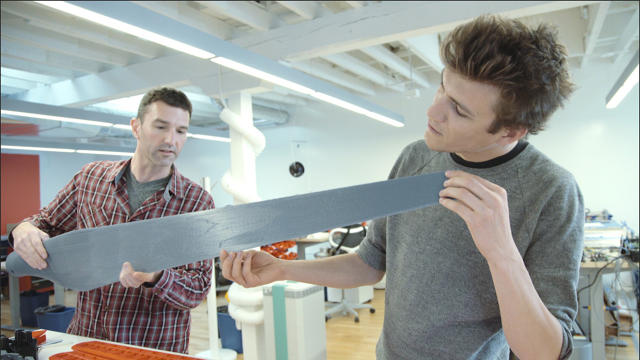"3-D printing is measured in ounces per hour, so if you need to print a 100-pound object and can only do an ounce an hour, well, you do the math," Autodesk's Corey Bloome says. (We did it for you: it's 66.7 days.) That's a big problem for manufacturers in industries like aerospace, automobiles, and construction, who want to leverage the capabilities of 3-D printing to mass produce new parts with unconventional geometries.
Autodesk's solution to the problem? Project Escher, which isn't so much a new kind of 3-D printer as it is a hive-mind of 3-D printers, networked together and working in unison to create huge objects in a fraction of the time it would normally take to produce.
Here's how it works. Let's say you want to print something huge, like the blade to a wind turbine. Autodesk's Project Escher software first takes the plans for that blade and intelligently slices it apart. It then hands a slice of the finished turbine to each individual 3-D printing "bot," placed in a gantry. There's no limits to the number of bots you can have in a gantry, says Bloome, who was the hardware lead for the project, it just depends how many 3-D printers you have. Working together, each bot 3-D prints its own section of the finished piece, until it's completed as one continuous, pre-assembled object.
The result is a unique kind of 3-D printing network that prints out faster the more bots are in the Project Escher array. Bloome tells me that it's 80% to 90% more efficient. In other words, if you have five bots in a Project Escher job, the finished design will print out around 4-4.5 times faster than it would with a single 3-D printer.

Project Escher isn't for hobbyists, though. With it, Autodesk is firmly targeting industries which build big and are stymied by the slow pace of conventional additive manufacturing. "If you're in aerospace, automotive, or construction, no one has 100 hours to print out just one thing," explains Kimberley Losey, Project Escher's product marketing lead. "At that scale, there's just tons of constraints for conventional additive manufacturing. So we thought, how can we solve that problem?"
Autodesk envisions Project Escher being used in any industry where you need to print big, but also customize what you're printing. One example Bloome gives is in car manufacturing, where you might want to customize a driver's seat to the unique contours of their body. Project Escher also allows for quickly printing out large objects with geometries not possible in other forms of manufacturing.

Project Escher could also be used in an automated assembly line. While right now the gantry isn't made up of anything but 3-D printers, Bloome says there's no reason robot arms can't be added to the network, so that non-additive elements like wires and circuit boards could be embedded during the printing process. Theoretically, you could 3-D print a complex object or gadget this way, like a car, without any humans being involved in the process once they hit Project Escher's start button.
That's far in the future, though. For now, Project Escher is still in the experimental phase. The next step, says Bloome, is to get companies actually using it, so they can see how it performs in a real-world manufacturing environment.
As for the cool ass name? Bloome admits that Project Escher doesn't really have much relation to M.C. Escher. "Basically, a bunch of our engineers got together, threw a bunch of code names at the wall, and everyone voted for the coolest name," he laughs.
All Images: via Autodesk